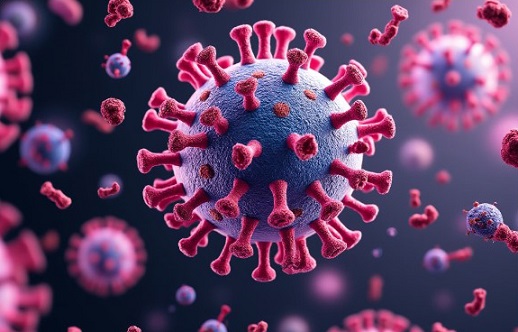Nikhil Prasad Fact checked by:Thailand Medical News Team Nov 22, 2024 4 months, 3 weeks, 7 hours, 44 minutes ago
Medical News: COVID-19 has left a trail of health complications that persist long after the initial infection. Among these, a troubling link has emerged between the virus and an increased risk of type 2 diabetes. For patients with pre-existing diabetes, COVID-19 often worsens their condition, leading to severe complications or even death. This
Medical News report sheds light on a fascinating yet concerning discovery about how SARS-CoV-2 proteins interact with a human protein called islet amyloid polypeptide (hIAPP), which is associated with type 2 diabetes.
 SARS-CoV-2 Proteins Linked to Diabetes Risk Through Amyloid Aggregation
SARS-CoV-2 Proteins Linked to Diabetes Risk Through Amyloid Aggregation
Recent research conducted by scientists from The Hong Kong University of Science and Technology (China) and The University of Oklahoma (USA) reveals that specific segments of SARS-CoV-2 proteins promote the formation of toxic amyloid aggregates in hIAPP. These findings could offer a new perspective on how the virus may exacerbate diabetes and open doors to novel therapeutic strategies.
How the Study Unfolded
The researchers focused on two amyloidogenic segments of SARS-CoV-2 proteins: SK9 from the viral envelope protein and FI10 from the spike protein. These segments have been implicated in the formation of amyloid-like clots, a hallmark of long COVID-19. The study aimed to understand their role in the aggregation and toxicity of hIAPP, particularly in membrane environments that mimic those in the human body.
Using advanced techniques like circular dichroism (CD), nuclear magnetic resonance (NMR), and molecular dynamics simulations, the team tracked how these viral segments altered the behavior of hIAPP. They also studied the effects of these interactions on cell membranes and tested their cytotoxicity through laboratory assays.
What Did the Study Find?
-SK9: Accelerating Toxic Fibril Formation
The SK9 segment was found to speed up the formation of fibrils - long, fibrous aggregates of hIAPP. This process occurs through inter-chain interactions, where multiple hIAPP molecules bind together. These fibrils are not only stable but also highly toxic, causing significant damage to cell membranes.
-FI10: Stabilizing Toxic Oligomers
In contrast, the FI10 segment stabilized hIAPP in its oligomeric form, which consists of smaller, less structured aggregates. Unlike SK9, FI10 promoted intra-chain interactions within single hIAPP molecules. These oligomers are just as harmful to membranes, albeit through a different mechanism.
-Diverging Pathways to Amyloid Aggregation
The study highlighted the distinct pathways by which SK9 and FI10 influence amyloid formation. While SK9 drove rapid fibrillization, FI10 hindered the elongation of fibrils but encouraged the accumulation of toxic oligomers. These findings suggest that viral protein segments can manipulate the aggregation behavior of host proteins, potentially amplifying the risk of amyloid-related diseases like diabetes.
t;
-Impact on Cell Membranes
Both SK9- and FI10-stabilized aggregates were shown to disrupt cell membranes. In laboratory tests, these aggregates caused leakage in artificial membranes and were toxic to pancreatic beta cells, which produce insulin. This damage aligns with the pancreatic dysfunction observed in type 2 diabetes and raises concerns about the long-term effects of COVID-19 on metabolic health.
What Makes These Findings Significant?
The interaction between viral proteins and hIAPP sheds light on a previously unexplored dimension of COVID-19's impact. It suggests that SARS-CoV-2 proteins not only cause immediate harm during infection but may also have long-lasting effects by promoting amyloid aggregation in critical tissues. This mechanism could explain why some COVID-19 patients develop new-onset diabetes or experience worsening symptoms.
Moreover, the differential effects of SK9 and FI10 provide valuable insights into how amyloid aggregation pathways can be manipulated. This knowledge could be pivotal in designing targeted therapies to counteract the toxic effects of viral protein segments and prevent diabetes-related complications in COVID-19 survivors.
Conclusion and Future Directions
In conclusion, the study highlights how specific segments of SARS-CoV-2 proteins influence the aggregation of hIAPP, a protein linked to type 2 diabetes. SK9 accelerates the formation of toxic fibrils, while FI10 stabilizes harmful oligomers. Both pathways lead to membrane damage and increased cytotoxicity, potentially worsening diabetes symptoms in affected individuals.
These findings emphasize the need for further research into the long-term metabolic consequences of COVID-19. Understanding how viral proteins interact with human amyloid proteins could pave the way for innovative treatments aimed at mitigating the risks of amyloid-related diseases. Additionally, the study underscores the importance of addressing the broader health implications of SARS-CoV-2 beyond its immediate effects on respiratory health.
The study findings were published in the peer-reviewed: International Journal of Biological Macromolecules
https://www.sciencedirect.com/science/article/abs/pii/S0141813024087415
For the latest COVID-19 News, keep on logging to Thailand
Medical News.
Read Also:
https://www.thailandmedical.news/news/covid-19-causes-insulin-resistance-in-non-diabetic-individuals
https://www.thailandmedical.news/news/the-silent-impact-of-insulin-resistance-on-health
